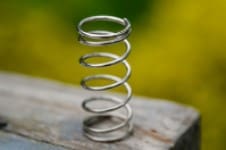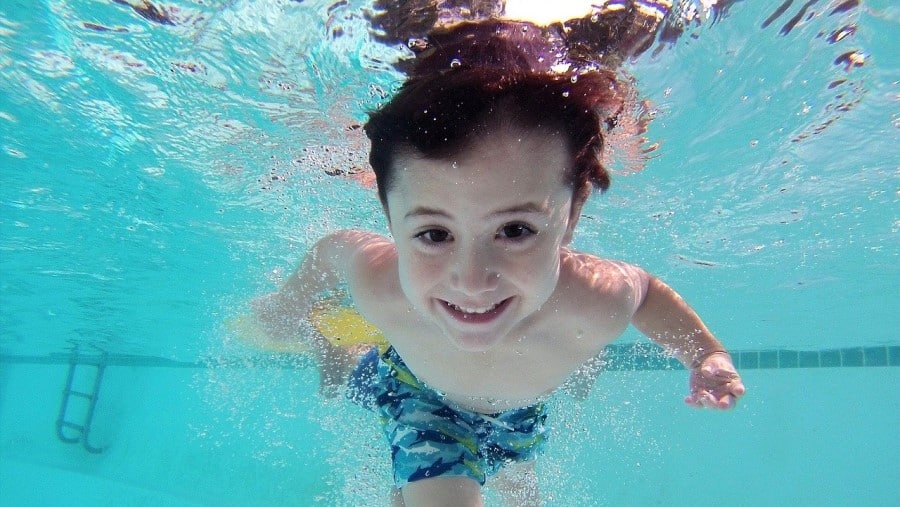Alkalinity matters in your swimming pool water balance, but why? Whether you are using test strips, or dropper type test kits you’ve likely seen the Total Alkalinity test. You may have even done the test, but why? Isn’t it just the same as the pH test?
Total alkalinity is the full measure of the total amount of alkaline type materials suspended in the water. Total alkalinity will buffer the impact of alkali or acid on the actual pH of the water. Target alkalinity in a pool is 80 to 150 parts per million and will help keep your pH within safe ranges.
So yes, it is true that pH and total alkalinity are related and closely linked, but the two are not one and the same. pH is based on a logarithmic scale or a range whereas total alkalinity is more along the lines of a percentage volume. Confused yet? Hang with me…
In this post, I will break down why your swimming pool or spas total alkalinity actually matters, and then when to make adjustments, and finally how to move total alkalinity up or down.
Always Adjust Alkalinity First.
It’s a common inclination to want to address the chlorine first in a swimming pool, but in the swimming pool and spa industry, there’s a common saying, “alkalinity first”, it’s even a brand of sodium bicarb. That is to say that before you address other aspects of swimming pool chemistry, make sure the alkalinity is in balance first.
Target Alkalinity in a swimming pool or spa is 80 to 150 ppm (parts per million.
Yes, total alkalinity is that important. Not only is pH directly linked to it, but so is the effectiveness of your sanitizer (chlorine) and other additives, the rate at which scaling will appear on surfaces, and even the longevity of the equipment.
The reason we don’t say “pH first” is because having the correct total alkalinity levels will stabilize or buffer the pH. What do we mean when we say “buffer”?

Try to imagine Total Alkalinity as a spring. The more coils on that spring, the more it will resist being compressed, alternatively the fewer coils there is the less resistance there will be and it will be easy to compress.
Target pH in a swimming pool or spa is 7.2 to 7.8
When the alkalinity is too low, the pH is very sensitive to change, also known in the swimming pool industry as pH bounce. For example, if total alkalinity is 0 ppm (parts per million) and the pH is 7.5, adding 1 gallon of liquid chlorine which has a pH of 13.0 in an average size pool the pH will spike to 8.0 or high pH. If the same pool had proper alkalinity levels to absorb, or buffer the pH change, there would actually be very little if any discernable change to the pH of the pool.
The Real 10X
No big deal, right? Remember that the pH scale is logarithmic, meaning that each whole number is 10x plus or minus the whole number next to it and the 10x that to the following number. So, a change from 7.5 to 8.0 is a 5x change. From a swimmer’s perspective, that means you go from enjoying your pool outing to now complaining of burning eyes and maybe even itchy skin. Your pool will slowly start to develop scaling inside the pipes and equipment, tile, and pool walls.
Depending on the type of materials used in your pool, along with your source water, your pool will tend toward certain characteristics. A vinyl or fiberglass pool will tend toward the lower end of the spectrum containing less alkaline materials and you may need to bring the total alkalinity up from time to time.
This is due to the non-porous nature of the pool liner material that has a neutral effect on the pool water. Concrete or plaster pools on the other hand have an abundance of alkaline material that slowly absorbs into the pool water which will rise in alkalinity over time. So you see it’s important to test often and understand your pool’s tendencies.
Increasing Total Alkalinity In a Swimming Pool
Supposing you have a vinyl liner, or fiberglass lined swimming pool or your source water is purified and free of almost all alkaline material, you will need to know how to raise your alkalinity. It’s important to note that if you choose to leave the alkalinity alone and just put up with pH bounce leaving the total alkalinity low for extended periods of time will;
- Etch your pool plaster
- Corrode the metals which include railings, lights, heaters, and plumbing
- Stain Plaster
- Cause pH to creep, plummet, or bounce
- Cause eye and skin irritation and rashes
- Lessen the effectiveness of sanitizer
Ultimately having low alkalinity will cause the pH to be unstable and wear out your equipment prematurely.
To bring your total Alkalinity up you can use multiple products, but the easiest is one of two products:
- Soda Ash if both the pH and the total Alkalinity are low, or
- Sodium bicarbonate (baking soda) to raise just the total alkalinity alone
The key to bringing up the alkalinity without overshooting it is to do it in steps, especially if you need to raise it a lot.
If you determine you need to bring the pH up along with the Alkalinity, you’ll want to use soda ash. 1 pound of soda ash in a 15,000-gallon pool will raise pH approximately 0.9 and the alkalinity by 17 ppm.
To raise total alkalinity and have little effect on pH use sodium bicarb. 1 pound of sodium bicarb in a 15,000-gallon pool will raise pH 0.3 and the alkalinity by 11ppm. The great benefit to sodium bicarb is that its fairly inexpensive.
If you have to raise alkalinity by more than 20 ppm, I always recommend doing it in partial doses so you don’t overshoot the mark.
Decreasing Total Alkalinity In A Swimming Pool?
This is a much more straightforward answer, but here again it’s important to know what can happen if high alkalinity goes unchecked. If your alkalinity is testing at 150 ppm or higher, it can cause:
- Scale formation
- Perpetually cloudy water
- Difficulty in bringing pH down
- Skin & Eye irritation
To bring the alkalinity into line you’ll want to use either dry acid or muriatic acid depending on what’s available in your location. Personally, I like to use muriatic acid. Just be careful because muriatic acid is very potent and should not be added when anyone is swimming or will be swimming within 1 hour. Also, muriatic acid often off gases from the container when it’s opened. Even when outdoors it can be quite noxious so make sure to wear adequate respiratory protection and stand upwind.
Using our same 15,000-gallon pool, to lower the alkalinity by 17 ppm, you will add ½ gallon of muriatic acid, or 5.25 pounds of dry acid.
Keep in mind that the acid will also drive down the pH, but that’s okay. Once you get the total alkalinity in line, the pH will follow, or it will be easier to adjust slowly afterward.
If you have trouble getting the pH lined up, try doing what most test kits call an acid demand test. This test will tell you exactly how much acid to add to bring down the pH. Following the directions on the test kit will give you a close idea of what will be needed.
One thing to really take note of:
Always read the directions on any labels of any of the chemicals mentioned here. It’s important to have the utmost respect for how dangerous some of these chemicals are. The doses mentioned in this article are ‘perfect’ scenario and often are hard to duplicate when not in a laboratory. So, as much as swimming pool and spa water chemical balance is literally a science, it is equally an art that develops the more you service your pool. So don’t get discouraged, keep working at it and soon you will have a very low maintenance swimming pool.
Check out the next article to see where pool algae come from and how to manage it.
Recent Posts
The Origin of Green Algae in Swimming Pools: Unveiling the Culprit
Swimming pools are synonymous with relaxation, fun, and refreshing dips during hot summer days. However, the appearance of green algae can turn this enjoyable experience into a frustrating one. Green...
At the heart of every pool is a filter pump that needs to be run every day for a specified length of time. Rather than try to remember to turn a pool pump on and off every day, pool builders and...


